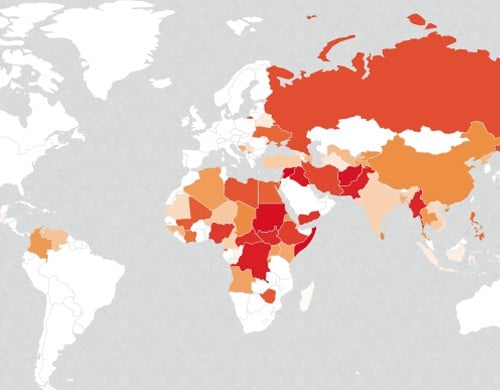
Threat to populations in the Middle East still greatest from government forces, despite ISIS
Threat levels to civilians in seven countries in the Middle East ranked highly in the 2015 Peoples under Threat global ranking have increased due to attacks by the Islamic State of Iraq and al-Sham (ISIS). However, overall, populations in the region are more at risk from their own governments, says Minority Rights Group International (MRG).
Attacks attributed to the opposition extremist group ISIS have spread in recent months to Lebanon, Yemen, Egypt, Libya and Afghanistan, and have intensified in Syria and Iraq, says the international rights organisation.
‘The threat to the Middle East from ISIS should not be under-estimated, but most people have more to fear from their own governments,’ says Mark Lattimer, MRG’s Executive Director. ‘Supporting anything or anyone who opposes ISIS could be a big mistake.’
The 2015 release of the Peoples under Threat index seeks to identify those communities around the world that are most at risk of genocide, mass political killing or systematic violent repression, and is available as an online map.
Syria, Iraq, Central African Republic, Egypt and Ukraine are amongst the most significant risers in the 2015 ranking.
With over 200,000 people now dead in the conflict and up to half of the population forced from their homes, the crisis in Syria,which for the first time tops the Peoples under Threat table, continues to worsen. Extreme sectarianism has now infected much of the country, with nearly all the remaining Christian communities living in enclaves in government-held areas. Only in the Kurdish-held regions of the north has there been a serious attempt at establishing an inclusive democracy, says MRG.
Iraq headed the table when the Peoples under Threat index was first published in 2006 and it has never been far from the top of the index in the intervening years. Over 14,000 civilians were killed in 2014, many of them in massacres perpetrated by ISIS as it expelled minority communities, including Yezidis, Shabak, Chaldo-Assyrians and Turkmen, from Mosul, Sinjar and the Ninewa plain. Thousands of Yezidi women and girls remain in ISIS captivity, and the risk remains acute for Shi’a communities threatened by ISIS and Sunnis at risk of retaliation from Iraqi Security Forces and allied Shi’a militias.
Conflict in the Central African Republic, which has risen 4 places this year to occupy number ten in the ranking, continued between the largely Muslim former Séléka rebels and anti-Balaka militias comprised mainly of Christians. Upwards of 850,000 people – nearly one-fifth of the country’s population – were refugees or internally displaced at the end of 2014, and many tens of thousands more fled their homes in the first months of 2015. A controversial peace agreement was signed in April 2015 between ex-Séléka and anti-Balaka leaders in Nairobi.
Egypt rose another three places in the index this year. Ongoing fighting and toughening security measures have affected the lives of Sinai Bedouin, who have long suffered political and economic marginalization. Human rights activists also continued to criticize the government for doing too little to provide security for Coptic and other Christian communities, especially in Upper Egypt, where individuals, their homes and places of worship regularly came under attack.
‘The dominance of Middle Eastern and African states in the 2015 Peoples under Threat table was perhaps inevitable,’ says Mark Lattimer. ‘But of equal concern is the rise in risk in two of the world’s major powers: Russia and China.’
.
In China, which has risen a dramatic 15 places in the table, there was a severe escalation in the tactics used by Uighur militants seeking independence in the Xinjiang Uighur Autonomous Region. Over 200 people were killed in terrorist attacks, hundreds detained in mass arrests and dozens of death sentences handed down. Little has been done, says MRG, to address the legacy of under-development and exclusion of Uighur communities that lies behind the unrest, and the government’s strategy of labelling Uighur human rights activists as terrorists has forestalled attempts to improve the situation.
The return of a more autocratic style of government in theRussian Federation, which occupies position 16 in the table, has coincided with rising xenophobia in Russian society against migrants, whether from abroad or from the Caucasus. But the threat is greatest in the North Caucasus itself, where regular clashes continue between Russian forces and Islamist separatists in Chechnya, Ingushetia, Kabardino-Balkaria and, particularly, Dagestan, says MRG.
While the rising threat level in the Russian Federation has left minorities there living in fear, Russia’s proxy war with Ukraine, which has risen a huge 39 places in the Peoples under Threatrankings, has seen whole communities in eastern Ukraine sheltering in their basements or pushed from their homes. Some two million Ukrainians have now been displaced within the east or have fled the country. Meanwhile, in Russian-annexed Crimea, the voices of human rights activists have been suppressed.
‘In both Donbas and Crimea, peoples’ rights have become the object of political manipulation. What we need now is to support better human rights monitoring on the ground, and to protect human rights defenders,’ says Lattimer.
2015 marks the 10th year of the Peoples under Threat rankings. Somalia, Sudan, Afghanistan and Iraq have consistently topped the table.
Notes to editors
-
Visit MRG’s online map which visualizes data from the Peoples under Threat index at www.peoplesunderthreat.org. View the map by year or by country, and find links to reports, press releases and further information on the communities under threat.
-
Download the full Peoples under Threat survey on MRG’s website on 20 May, with a description of how it is compiled.
-
Minority Rights Group International is the leading international human rights organization working to secure the rights of ethnic, religious and linguistic minorities and indigenous peoples. We work with more than 150 partners in over 50 countries.